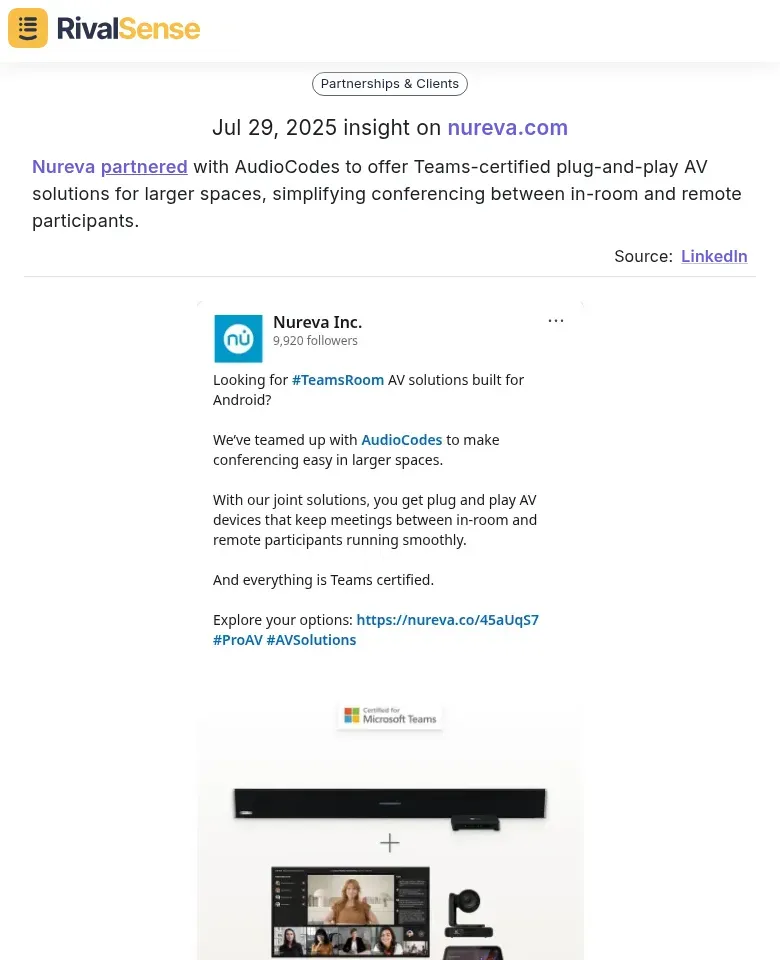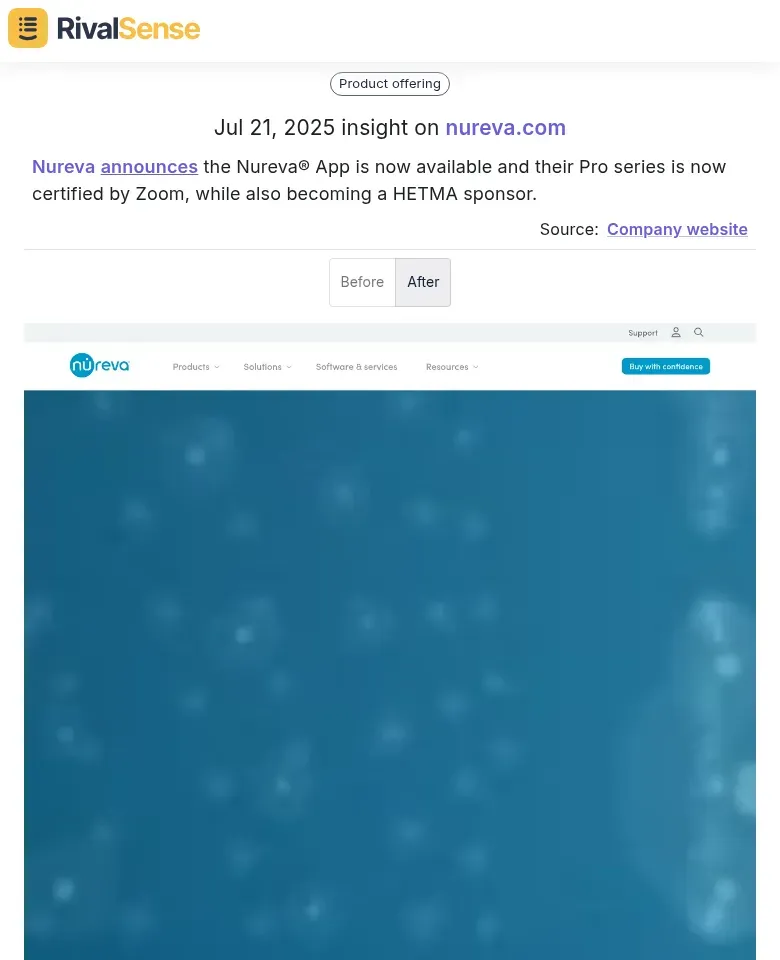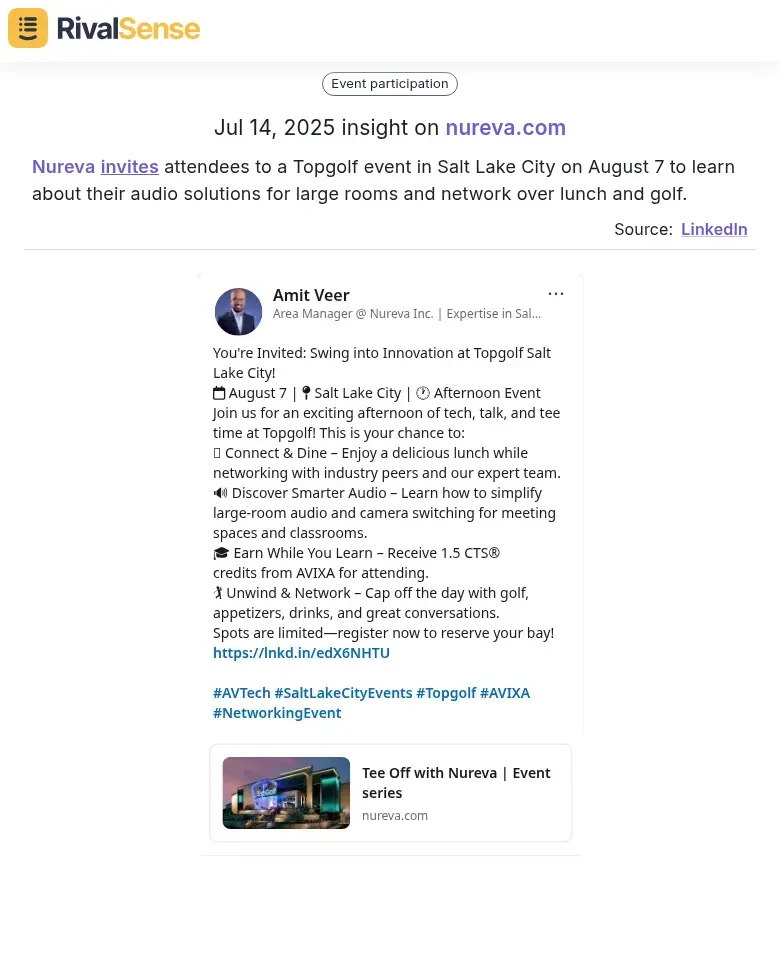Ultimate Audio Conferencing Key Account Review Checklist
In the competitive B2B audio conferencing landscape, strategic key account reviews are essential for maintaining your competitive edge. Regular reviews help identify growth opportunities and prevent client churn by proactively addressing issues before they escalate. For example, schedule quarterly business reviews (QBRs) with key accounts to assess usage patterns, gather feedback, and align on goals.
Tracking competitor partnership strategies can reveal valuable opportunities. For instance, Nureva partnered with AudioCodes to offer Teams-certified plug-and-play AV solutions for larger spaces, simplifying conferencing between in-room and remote participants. This type of partnership insight can inspire your own collaboration strategies and help you identify potential integration partners.

Leverage competitor partnership strategies by pursuing platform certifications (like Microsoft Teams or Zoom certifications) and developing integrations that enhance your solution's value. Practical tip: Create a standardized review checklist that includes assessing integration opportunities, evaluating competitor offerings your clients might consider, and identifying cross-sell/upsell potential based on usage data. This proactive approach transforms account management from reactive support to strategic partnership.
Pre-Meeting Preparation and Research
Start with comprehensive competitor analysis to identify market positioning and partnership opportunities. Use tools like RivalSense to track competitors' pricing, features, and customer feedback. Analyze their strengths and weaknesses to position your audio conferencing solution effectively.
Review client usage data to uncover patterns—peak usage times, feature adoption rates, and support ticket trends. Examine contract terms for renewal dates, pricing tiers, and service level agreements (SLAs). Scrutinize previous meeting notes for unresolved issues or recurring themes to address proactively.
Identify key stakeholders and decision-makers using LinkedIn and internal CRM data. Map their roles, influence levels, and pain points. Tailor the agenda to address their specific concerns, ensuring alignment with business objectives. This targeted approach maximizes engagement and drives actionable outcomes.
Structuring the Account Review Meeting
Structuring an effective account review meeting requires a focused agenda that drives value and addresses client needs. Start by creating a clear agenda with time allocations: 5 minutes for opening and rapport building, 15 minutes for value delivery review (highlighting ROI, usage metrics, and problem-solving achievements), 10 minutes for competitor insights, 10 minutes for addressing client pain points and future opportunities, and 5 minutes for action items and next steps.
Monitoring competitor certifications and industry participation can provide powerful talking points. For example, Nureva announced their Pro series is now certified by Zoom while also becoming a HETMA sponsor. This type of insight demonstrates how tracking competitor certifications and event participation can help you showcase your own industry leadership during client meetings.

Set SMART objectives: Specific (e.g., secure renewal commitment), Measurable (e.g., identify 2 new use cases), Achievable (e.g., address 3 key concerns), Relevant (aligned to client goals), and Time-bound (30-minute meeting). Distribute the agenda 48 hours in advance with pre-reading materials. This structured approach ensures efficiency, measurable outcomes, and reinforces your value proposition against the competitive landscape.
Evaluating Performance and Identifying Opportunities
Evaluating performance requires benchmarking against both client goals and competitor metrics. Start by analyzing call quality metrics like MOS scores (1-5 scale), audio delay, and network utilization—Zoom leads with 30/40 overall score vs. Webex's 31, Teams' 43, and Meet's 36 in 2024 tests. Track client-specific KPIs: uptime, participant satisfaction scores, and support response times.
For upsell opportunities, leverage conversational analytics to identify unmet needs—87% of attendees value product discovery at events. Cross-sell adjacent services like enhanced security features or AI-powered transcription, aligning with trends showing 80% of events teams value AI for personalization.
Draw inspiration from competitor networking strategies: 81% of attendees prioritize expert networking. Implement quarterly client roundtables or industry webinars mirroring successful formats like hybrid events (40.6% attendee preference). Use competitor event data to tailor engagement—offer exclusive previews or co-hosted sessions to deepen relationships and uncover expansion opportunities.
Action Plan and Follow-Up Strategies
Transform your audio conferencing key account reviews into actionable growth engines with this strategic follow-up framework. First, develop a customized 90-day action plan immediately after each review session. Assign clear ownership for each initiative—designate a primary contact responsible for implementation, with specific deadlines.
Competitor event tracking can inspire creative engagement strategies. For instance, Nureva invited attendees to a Topgolf event in Salt Lake City to learn about their audio solutions while networking over lunch and golf. This type of insight shows how monitoring competitor events can help you develop more engaging client interaction strategies.

Use a RACI matrix to clarify roles: Responsible, Accountable, Consulted, and Informed parties. Implement bi-weekly progress check-ins via 15-minute standup calls, tracking metrics like client usage frequency, feature adoption rates, and satisfaction scores. Create a shared dashboard visible to both teams for transparency.
For competitor-inspired collaboration, analyze partnership models from leaders like Zoom's app marketplace or Cisco's technology alliances. Propose co-development opportunities—perhaps integrating your conferencing solution with the client's project management tools, mirroring successful integrations you've observed in the market. Schedule quarterly strategic sessions to review partnership evolution and adjust tactics based on performance data and competitive landscape shifts.
Measuring Success and Continuous Improvement
To effectively measure success and drive continuous improvement in your audio conferencing key account management, implement these strategic practices:
Track Essential Metrics: Monitor client satisfaction (CSAT scores above 85%), retention rates (target 90%+), and revenue growth from key accounts. Use tools like Gainsight or custom dashboards to track Net Promoter Score (NPS), Customer Effort Score (CES), and churn rates monthly. For example, if retention drops below 85%, immediately investigate root causes.
Conduct Post-Review Surveys: Send automated surveys within 24 hours of each account review using tools like SurveyMonkey or Typeform. Ask specific questions about meeting effectiveness, action item clarity, and overall value. Analyze feedback to identify patterns - if multiple clients mention unclear pricing, revise your communication strategy.
Monitor Competitor Moves: Set up alerts for key competitors (Zoom, Microsoft Teams, RingCentral) and track their feature releases, pricing changes, and client testimonials. Use competitive intelligence tools to monitor their market positioning and adapt your strategy accordingly. For instance, if a competitor launches AI-powered meeting summaries, evaluate implementing similar features.
Practical Checklist:
- ✅ Monthly metric review meetings with your account team
- ✅ Quarterly competitive analysis reports
- ✅ Immediate follow-up on survey scores below 4/5
- ✅ Competitive intelligence alerts for pricing changes
- ✅ Client feedback implementation tracking system
Continuously refine your approach based on data-driven insights to maintain competitive advantage and drive account growth.
Ready to elevate your competitor intelligence? Try RivalSense for free and get your first competitor report today to stay ahead of partnership opportunities, product launches, and industry events that could impact your key account strategy.
📚 Read more
👉 How to Turn Competitor Regulatory Insights into Key Account Growth
👉 GF Inbursa Increases Telcel Oro Credit Card Fees: A Competitor Analysis Breakdown
👉 Business Partnership Training Programs: Best Practices & 2025 Implementation Guide
👉 Measure Custom Software Partnership ROI: Key Metrics and Practical Strategies
👉 How Caterpillar Countered Rolls-Royce's Saudi Rail Win: A Competitive Intelligence Case Study
